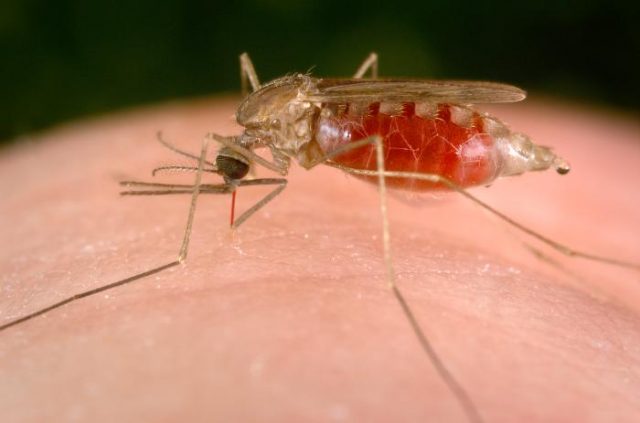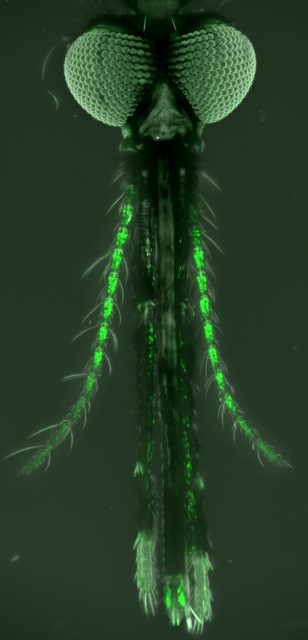Change your flavor
Flavor is a brain construction: we have olfactory and taste receptors and our central nervous system combines both types of information in what we call flavor. Malaria is an infectious disease affecting humans and other animals caused by parasitic protozoans belonging to the Plasmodium genre. It is transmitted by the bite of the female Anopheles gambiae mosquito that detect its target —frequently us— through sensory neurons. In 2015, sanitary organizations estimate malaria affected 214 million people, mostly in Africa, and was responsible for around 450,000 deaths. The control of these insects is therefore an important and necessary scientific challenge.

Female Anopheles gambiae mosquitoes are strongly anthropophillic and prefer to bloodfeed on humans over other animals. It is known that they detect humans using olfactory cues and are likely to use these chemical signals to distinguish humans from other animals. However, relatively little is known about the pathways of olfaction in the mosquito brain. Female mosquitoes have nerve cells called cpA neurons that have a dual-receptor to detect both carbon dioxide and skin odor. This enables them to sense the plumes of air we exhale and our body odor and find us in the darkness for a blood meal. Olfactory receptors are known to help distinguish human beings from other warm-blooded animals in Aedes aegypti mosquitoes, the responsible of Zika virus contagion. Because detection is crucial to mosquito reproduction —females need blood to raise their brood— each mosquito has three pairs of «noses» for sensing odors: two antennae, two maxillary palps and two labella 1. The maxillary palps are thick, fuzzy appendages that protrude from the lower region of the mosquito’s head, parallel to its proboscis, the long, flexible sheath that keeps its «feeding needle» under wraps until biting time. At the very tip of the proboscis are the labella, two small structures that contain both gustatory and olfactory sensory neurons, that therefore combine detection of taste and smell.
Olena Riabinina and her group from Johns Hopkins University used binary gene expression to develop transgenic lines of Anopheles gambiae in which olfactory receptor neurons expressing the odorant receptor co-receptor (Orco) gene are labeled with GFP, and thus glow green under an appropriate light 2. Olfactory receptor neurons in all insects require an obligatory Orco and thus all are labeled with this technique. As expected, olfactory receptor neurons from the antennae and maxillary palps send their axons to the symmetrical areas of the insect brain called antennal lobes. Surprisingly, the olfactory receptor neurons from the labella project to the so-called subesophageal zone. This zone had never before been associated with the sense of smell in any insect; it had only been associated with the sense of taste. All this suggests that integration of olfactory and gustatory information occurs in this brain region and thus, this specialized area of the mosquito brain mixed tastes with smells to create unique and preferred human flavors.

It seems plausible that the mosquitoes operate in a sequential manner. Antennae and maxillary palps are more specialized in long-distance detection and help to find a target, a mammal. By contrast, the labella come into direct contact with the skin and then they detect the flavor of its victim probably differentiating between humans and other species. If this information is positive, the mosquito pierces the human’s thick skin with its needlelike proboscis and it quickly wiggle it around until it hits a blood vessel, infecting with plasmodia at the same time.
Another interesting result provided by the clear labeling of sensory neurons, was the comparison of the brains of male and female mosquitoes. Since males only feed on nectar, it was previously thought that they had just a poor sense of smell. The Johns Hopkins research group found instead that males have the same level of complexity on the odor circuitries as females but males have fewer olfactory receptor neurons. Probably they can smell the same molecules a female smells, just no with the same detection and discrimination capacities.
Hopefully, these results open new possibilities to fight against mosquitoes that is also to fight against malaria. We can search for an odorant that is safe and pleasant-smelling for us but strongly repellant to mosquitoes at very low concentrations. A combination of repellants could keep mosquitoes from biting us in two ways. One could target the antennal receptor neurons and reduce the likelihood that they approach us, while another could be directed to the labellar neurons and make the mosquitoes turn away in disgust if they land on us. 3 It will be also interesting to understand how signals from the mosquitoes’ three groups of olfactory receptor neurons interact to influence the insect behavior. With only 100,000 neurons the insect brain is a good model to understand the neural basis of perception, to understand how the sensory world is represented in our mind, and to develop new methods to combat insect pests that pose a threat to human health, the goals of the research team lab.
References
- Altering the ‘flavor’ of humans could help fight malaria. Scienmag ↩
- Riabinina O, Task D, Marr E, Lin CC, Alford R, O’Brochta DA, Potter CJ (2016) Organization of olfactory centres in the malaria mosquito Anopheles gambiae. Nat Commun 7: 13010. doi: 10.1038/ncomms13010 ↩
- Novel study identifies an area of the mosquito brain that mixes taste and smell. Phys Org. ↩